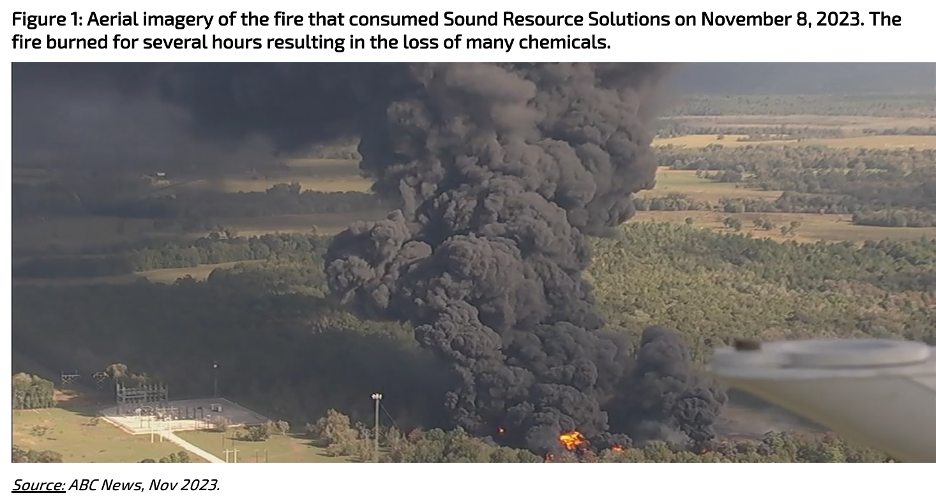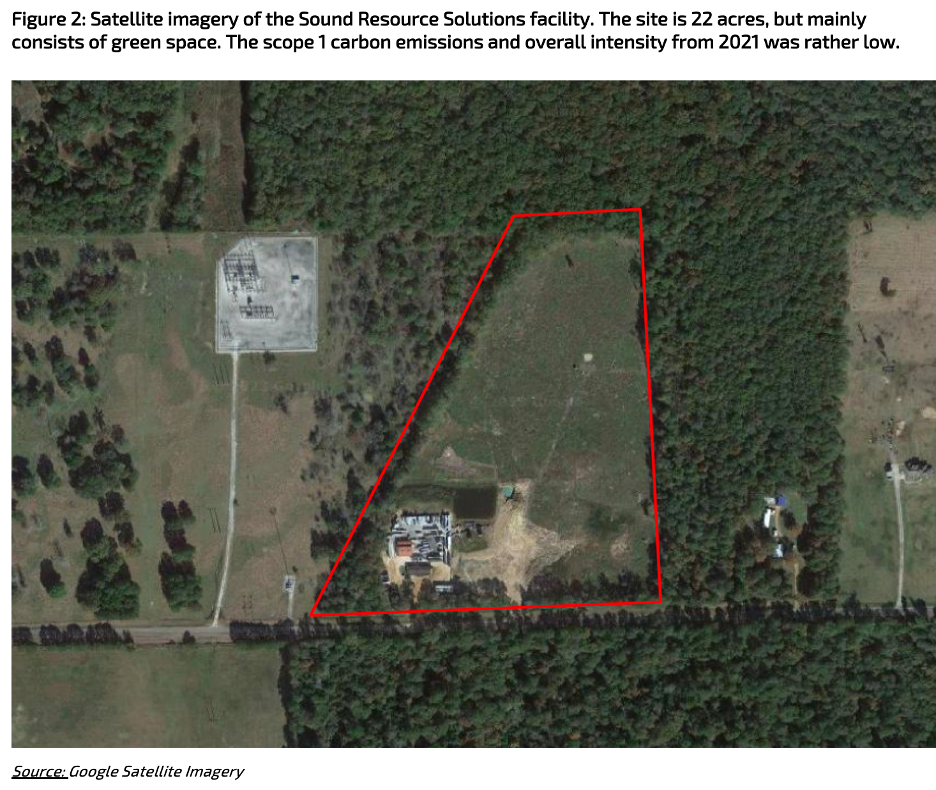Key Takeaways
- A large chemical fire occurred on November 8, 2023, at Sound Resource Solutions.
- Phosphoric acid and xylene were among the chemicals stored at this facility.
- The fire impacted carbon emissions and is driving public health concerns.
On the morning of November 8, 2023, a forklift lifted a leaking chemical tank at a chemical storage/transport facility in Shepherd, Texas. Upon lifting the tank, a fire quickly erupted; the expanding blaze resulted in the combustion of many chemicals stored at the facility. Billows of smoke from the fire’s source traveled to nearby areas, resulting in shelter-in-place orders, school evacuations, and complete traffic closures. The fire was eventually controlled by the afternoon, but still generated a variety of important effects to analyze.

According to Sound Resource Solutions’ website, the facility stores many acids, the most notable being phosphoric acid. Although it is unclear if phosphoric acid was burned during the incident, there are still a few significant elements to note. According to the state of New Jersey’s hazardous substance fact sheet, phosphoric acid is not combustible on its own. However, when this substance comes into contact with metals, flammable hydrogen gas can be produced. If a fire does occur, toxic phosphorous oxides are formed. These gases are poisonous and can severely impact public health. Fortunately, no traces of these gases were detected by the instrumentation that monitored this event. However, it is essential to continue analyzing remotely sensed data to confirm that there are no future damages to the land, water, or air. Knowing the significance of sustainability, Floodlight is constantly monitoring the risks that toxic chemicals may create for populations and resources.
In addition to the acids located at the site, there were also many aromatics, including xylene and acetone, and alcohols, including isopropyl alcohol, methane, and hexane. These groupings of chemicals are important because when they react with oxygen in a combustion reaction, carbon dioxide (CO2) is produced.

From Floodlight’s SAGE product, the scope 1 emissions at this site for the year 2021 were calculated to be about 12.5 metric tons of CO2. The resulting intensity is recorded at .000013 metric tons CO2 per square foot. This intensity initially seems astonishingly low but makes more sense with some contextual points. First, the location is comprised mostly of green space and there is even more forest in the surrounding area. Second, the main operations before the fire included storage and distribution of the chemicals. These processes are not very carbon intensive, especially when compared to other types of chemical industries. It would be expected for this facility to have a larger scope 3 footprint which would come from the manufacturing of the raw chemical components, and the further use of the blended products.
When the fire happened, part of what would have been included in the scope 3 footprint (end use of the chemicals) quickly became scope 1 emissions. Although some of the products from this company would’ve ended up as fuel, direct and uncontrolled burning of the aromatics and alcohols releases a tremendous amount of CO2. This sudden influx of carbon into the atmosphere can further contribute to climate change.
According to work done by the Coalition to Prevent Chemical Disasters, there have been more than 200 toxic chemical releases, fires, or explosions in the last year. The frequency of these events make them far too important to miss when it comes to GHG and other toxic gas emissions reporting. Floodlight recognizes the magnitude of change that are caused by these environmental disasters and therefore remains committed to using scientifically derived methods in order to directly measure emissions, no matter the circumstance.
Citations:
ABC News Network. (2023, November 8). Massive fire reported at chemical plant outside Houston. ABC News. https://abcnews.go.com/US/video/massive-fire-reported-chemical-plant-houston-104726138
Ahmad, Z. (2023, February 27). New Map shows toxic chemical releases, fires, and explosions happen every two days in the U.S. Earthjustice. https://earthjustice.org/press/2023/new-map-shows-toxic-chemical-releases-fires-and-explosions-happen-every-two-days-in-the-u-s
Our products. Sound Resource Solutions – Our Products. (n.d.). https://www.soundrs.net/our-products, Phosphoric Acid. Retrieved November 17, 2023, from https://www.nj.gov/health/eoh/rtkweb/documents/fs/1516.pdf.

